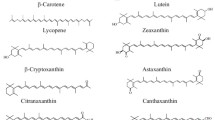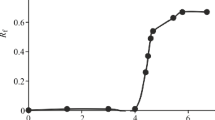Abstract
A method to analyze cholesterol and 10 of its oxidation products, ranging from the weakly polar cholest-4-ene-3,6-dione to moderately polar cholest-5-ene-3β,7α-diol, in a single run is described. The separation was achieved by normal-phase gradient high-performance liquid chromatography with an evaporative light-scattering detector. This universal mass detector does not detect changes in solvent composition; this makes it possible to employ gradients, an essential technique whenever a wide range of compounds with diverse characteristics is to be separated. Standards at concentrations from 0.1–1.0 µg were separated within 37 min on an alumina/silica column with a gradient elution system that contained dichloromethane, acetonitrile, and water.
Similar content being viewed by others
References
Peng, S.-K., and C.B. Taylor, Cholesterol Autoxidation, Health and Arteriosclerosis: A Review on Situations in Developed Countries, World Rev. Nutr. Diet 44:117–154 (1984).
Bischoff, F., and G. Byron. The Pharmacodynamics of and Toxicology of Steroids and Related Compounds, Adv. Lipid Res. 15:96–102 (1977).
Sevanian, A., and A.R. Peterson, Cholesterol Epoxide Is a Direct-Acting Mutagen, Proc. Nat. Acad. Sci. USA 81:4198–4202 (1984).
Teng, J.I., M.J. Kulig, and L.L. Smith, Gas Chromatographic Differentiation Among Cholesterol Hydroperoxides, J. Chromatogr. 75:108–113 (1973).
Smith, L.L., in Cholesterol Autoxidation, Plenum Press, New York, 1981, pp. 5–6.
Tsai, L.S., K. Ijichi, C.A. Hudson, and C.C. Meehan, A Method for the Quantitative Estimation of Cholesterol A-Oxide in Eggs, Lipids 15:124–128 (1980).
Chicoye, E., W.D. Powrie, and O. Fennema, Photoxidation of Cholesterol in Spray Dried Egg Yolk upon Irradiation, J. Food Sci. 33:581–587 (1968).
Moreau, R.A., Quantitative Analysis of Lipids by HPLC with a Flame Ionization Detector or an Evaporative Light-Scattering Detector, in Lipid Chromatographic Analysis, edited by T. Shibamoto, Marcel Dekker, Inc., New York, 1994, Chapter 7, pp. 251–272.
Stolyhwo, A., D. Colin, and G. Guiochon, Use of Light Scattering as a Detector Principle in Liquid Chromatography, J. Chromatogr. 265:1–18 (1983).
Mourey, T.H., and L.E. Oppenheimer, Principles of Operation of an Evaporative Light Scattering Detector for Liquid Chromatography, Anal. Chem. 56:2427–2434 (1984).
Mourey, T.H., and L.E. Oppenheimer, Examination of the Concentration Response of Evaporative Light Scattering Mass Detectors, J. Chromatogr. 323:297–304 (1985).
Stolyhwo, A., M. Martin, and G. Guiochon. Analysis of Lipid Classes by HPLC with Evaporative Light Scattering Detector, J. Liquid Chromatogr. 10:1237–1253 (1987).
Spanos, G.A., and S.J. Schwartz, Determination of Cholesterol in Milk Fat by Reversed Phase HPLC and Evaporative Light
Author information
Authors and Affiliations
Corresponding author
About this article
Cite this article
Lakritz, L., Jones, K.C. Separation and quantitation of cholesterol oxides by HPLC with an evaporative light scattering detector in a model system. J Amer Oil Chem Soc 74, 943–946 (1997). https://doi.org/10.1007/s11746-997-0008-1
Issue Date:
DOI: https://doi.org/10.1007/s11746-997-0008-1




